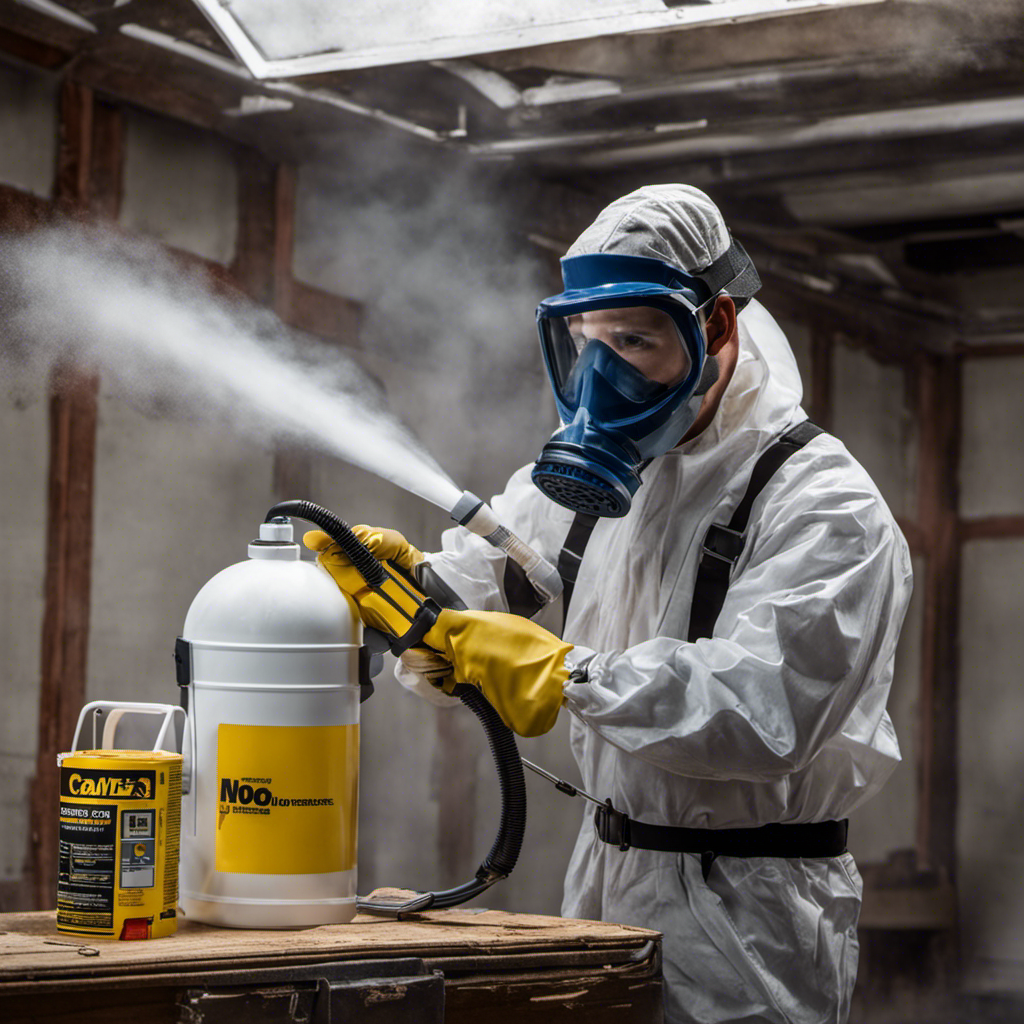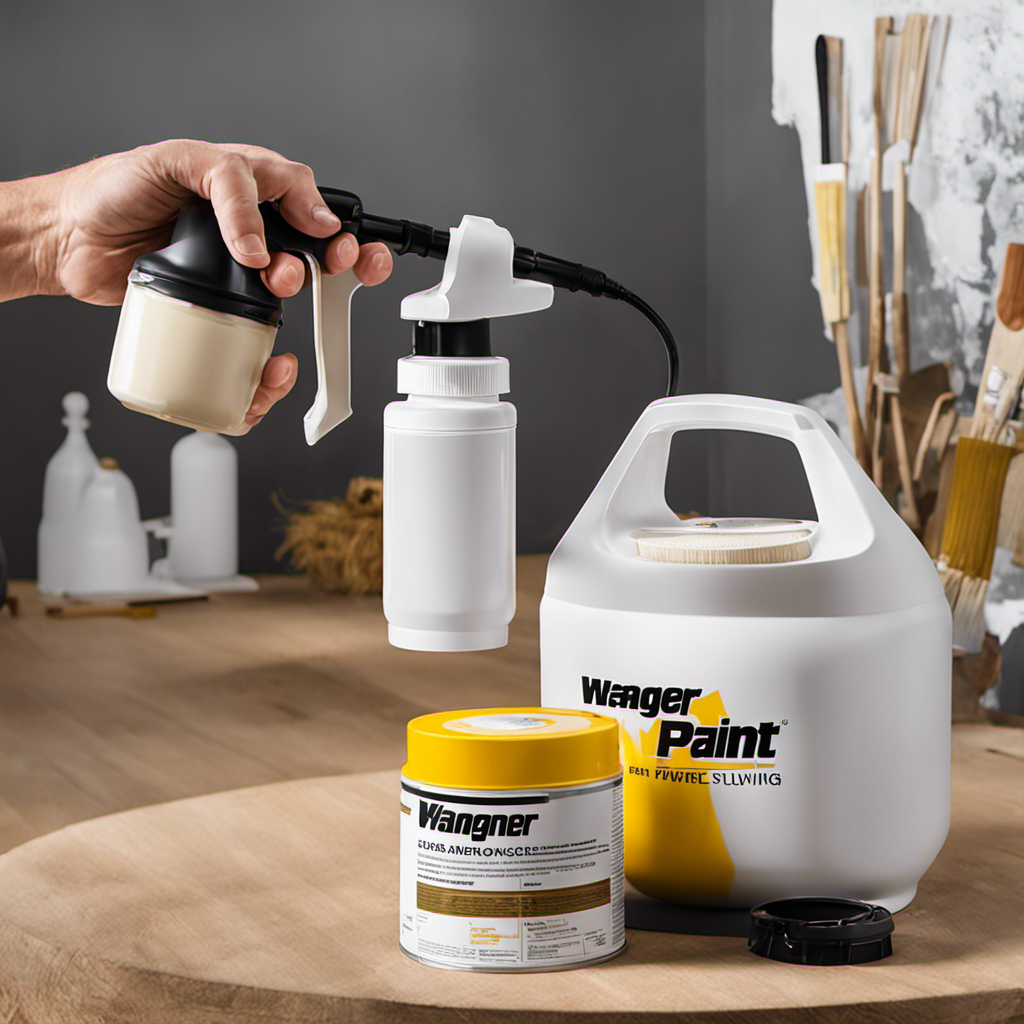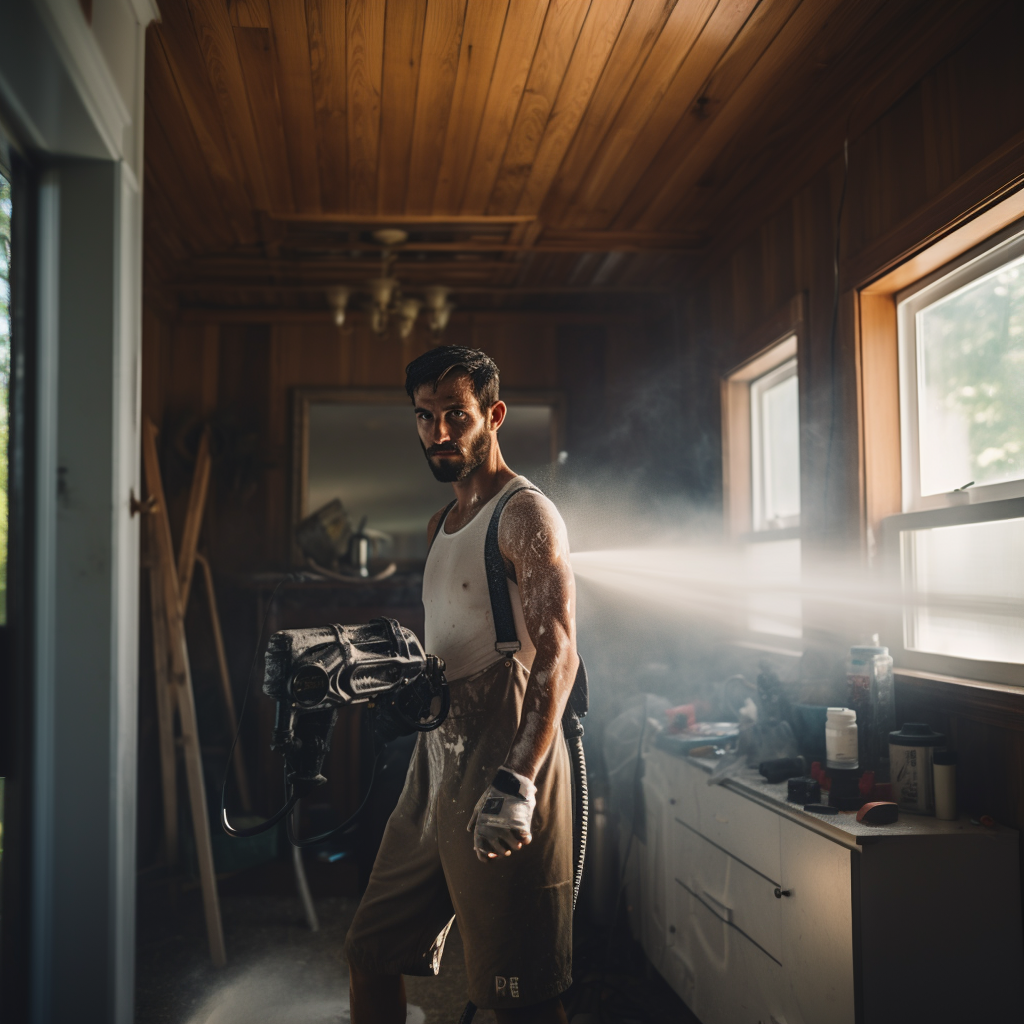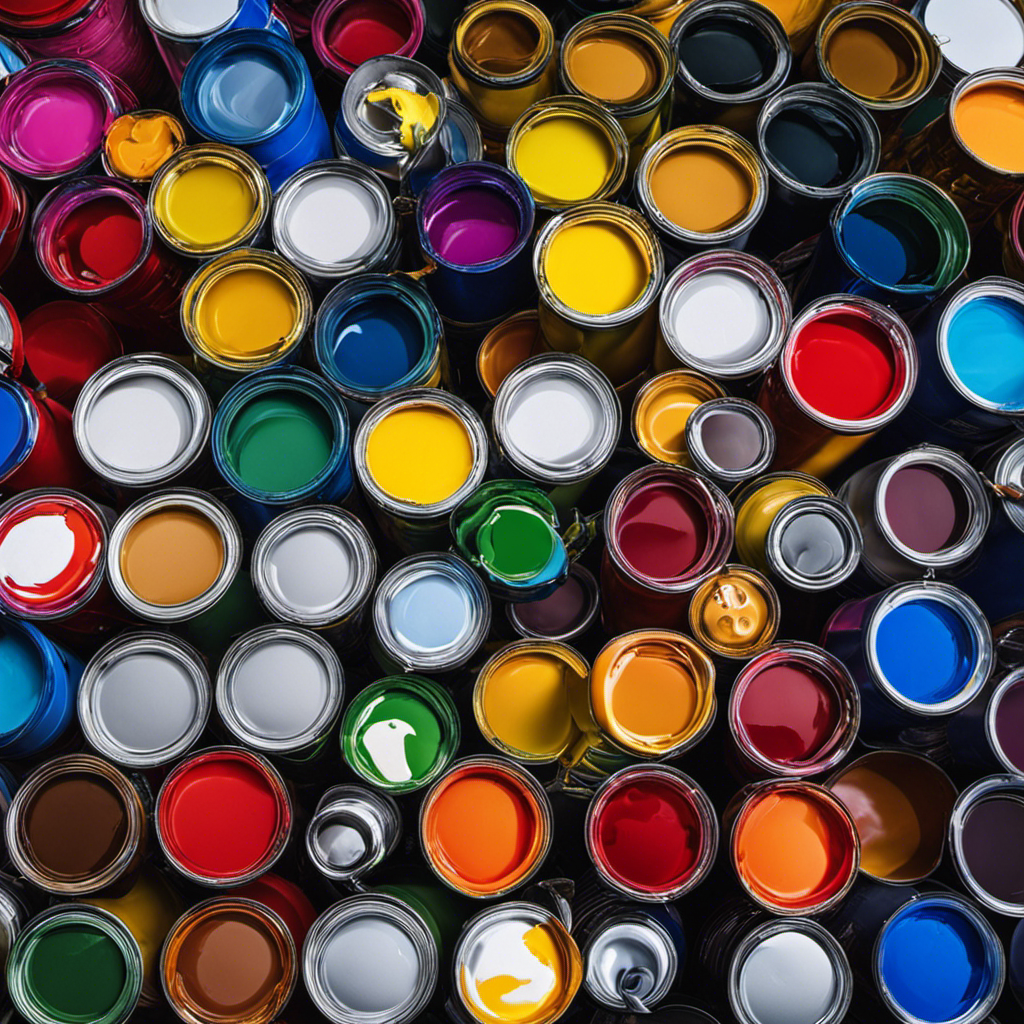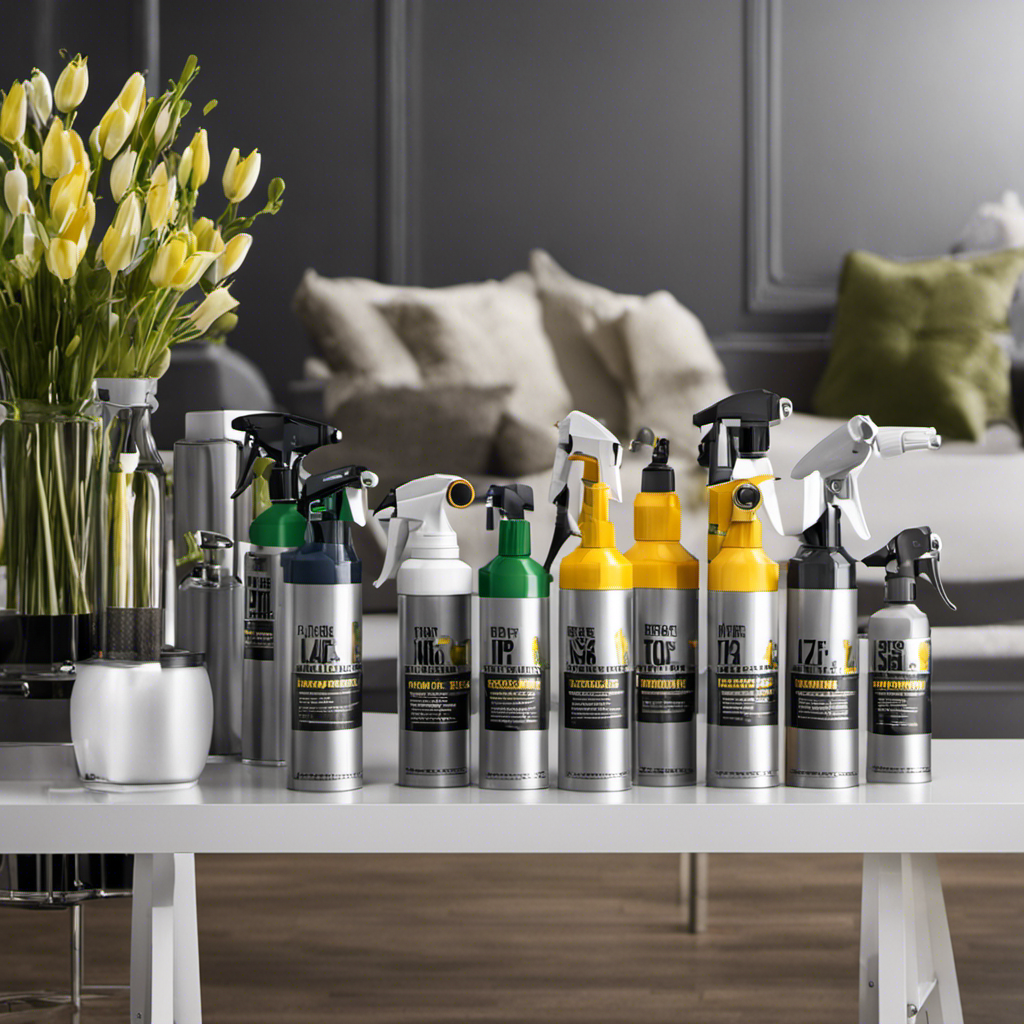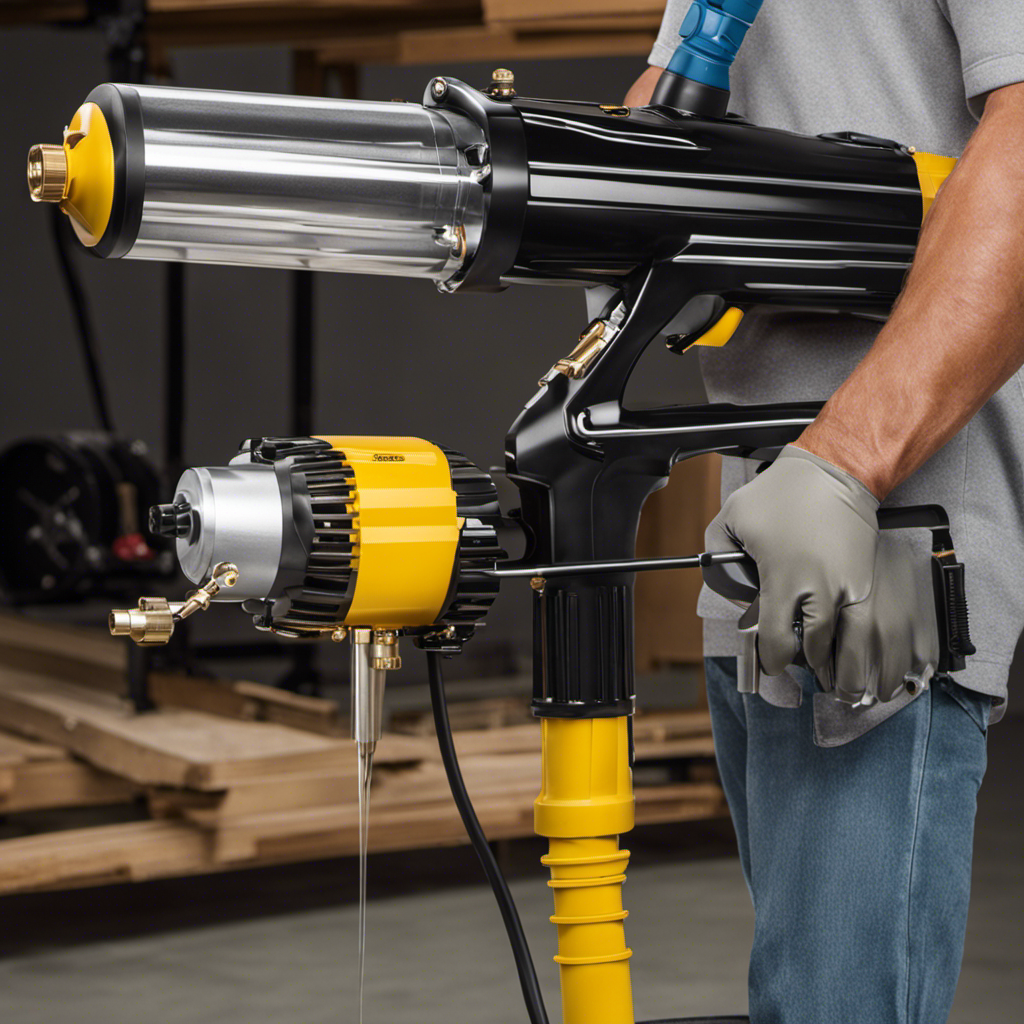Airless paint sprayers are highly preferred by professionals in the painting industry, with over 70% relying on them for fast and high-quality results. Nevertheless, it is essential to prioritize safety when using these powerful tools.
Every year, thousands of injuries occur due to improper handling of airless sprayers. In this article, we will explore essential airless paint sprayer safety tips to minimize risks and ensure a safe working environment.
By following these guidelines, both professionals and DIY enthusiasts can protect themselves and achieve outstanding painting outcomes.
Key Takeaways
- Always wear appropriate protective clothing, such as goggles, gloves, and coveralls, when using an airless paint sprayer.
- Ensure proper ventilation in the spraying area to prevent inhalation of harmful fumes.
- Keep flammable materials away from the spraying area to minimize the risk of fire and explosions.
- Regularly inspect and maintain your equipment to prevent leaks and ensure safe operation.
Understanding the Basics of Airless Paint Sprayer Safety
Understanding the basics of airless paint sprayer safety involves familiarizing oneself with the potential hazards, such as fire risks and injection injuries, and taking necessary precautions to minimize these risks.
One important aspect of safety is preventing overspray accidents. This can be accomplished by using drop cloths or plastic sheets to cover nearby surfaces and objects, ensuring that only the intended area is being sprayed.
Another crucial safety measure is the safe disposal of paint waste. It is important to follow proper procedures for disposing of paint waste to avoid environmental contamination and potential health hazards. This includes properly sealing and labeling containers, and disposing of them in accordance with local regulations.
Potential Hazards and Risks Associated With Airless Paint Sprayers
Potential hazards and risks associated with airless paint sprayers include:
- Fire and explosions
- Injection injuries
- Leaks
- Inadequate ventilation
- Inhalation of harmful fumes
To prevent fire, it’s crucial to keep flammable materials away from ignition sources. Protective gear, such as goggles, gloves, and coveralls, plays a vital role in minimizing the risk of injection injuries.
Proper ventilation is essential to prevent the inhalation of harmful fumes. To ensure fire prevention, it’s important to have a fire extinguisher readily available in case of emergencies. Additionally, covering nearby surfaces and objects with drop cloths or plastic sheets can prevent accidental overspray.
Using a respirator mask can protect against the inhalation of paint fumes. Regularly inspecting and maintaining the equipment is necessary to prevent leaks and ensure proper functioning.
Importance of Protective Clothing and Gear
Wearing appropriate protective clothing, such as goggles, gloves, and coveralls, is crucial for minimizing the risk of injury when using an airless paint sprayer. The importance of eye protection cannot be overstated, as the high-pressure stream of paint can cause serious harm if it comes into contact with the eyes.
In addition to goggles, it is also recommended to use a respirator mask to properly protect against the inhalation of paint fumes. These fumes can be harmful and may lead to respiratory issues if not properly addressed.
Ensuring Proper Ventilation in the Spraying Area
Proper ventilation is crucial to minimize the inhalation of harmful paint fumes in the spraying area. Ensuring adequate airflow is essential for maintaining a safe working environment when using an airless paint sprayer.
Here are some key points to consider regarding the importance of proper ventilation and potential health risks:
- Proper ventilation helps to remove and dilute paint fumes, reducing the risk of inhalation and associated health issues.
- Inadequate ventilation can lead to the buildup of hazardous fumes, increasing the potential for respiratory problems and other health risks.
- Ventilation systems, such as fans or exhaust vents, should be used to effectively remove fumes from the spraying area.
- Opening windows and doors can also help to improve ventilation and fresh air circulation.
- Regularly monitoring the air quality using air quality meters can provide valuable information about the effectiveness of ventilation and help ensure a safe working environment.
Fire Safety Measures for Airless Paint Sprayers
Fire extinguishers should always be readily accessible in the spraying area when using an airless paint sprayer. Fire prevention is crucial to maintaining a safe working environment. To ensure safety, it is important to store flammable materials away from ignition sources.
Proper ventilation is also essential to prevent the buildup of hazardous fumes. Additionally, safe storage of the airless paint sprayer is vital. It should be kept in a cool and dry area, away from direct sunlight or extreme temperatures. This helps to prevent any potential fire risks.
Preventing Injection Injuries: Best Practices
Inspecting the equipment regularly for leaks and promptly addressing any issues is an important step in preventing injection injuries when using an airless paint sprayer. Here are some additional tips to ensure safe handling techniques and prevent paint overspray:
- Always wear appropriate protective gear, including gloves, goggles, and coveralls, to protect against contact with paint and harmful chemicals.
- Maintain proper ventilation in the spraying area to prevent inhalation of fumes.
- Keep the spray gun pointed away from yourself and others at all times to avoid accidental injuries.
- Clean and maintain your equipment regularly to prevent leaks and ensure proper functioning.
- Use tip guards to prevent overspray and protect against injuries from high-pressure paint streams.
Detecting and Addressing Equipment Leaks
In order to ensure safe and efficient operation of an airless paint sprayer, it is important to detect and address any equipment malfunctions promptly. One common issue that may arise is equipment leaks, which can lead to contact with hazardous chemicals or create slippery surfaces. To address this problem, regular inspection of the sprayer for leaks is crucial. Additionally, it is important to regularly inspect all parts of the sprayer for wear or damage and replace them as needed. This will help prevent leaks and ensure the proper functioning of the equipment. Another issue that may occur is paint overspray, which can result in wasted paint and potential damage to nearby surfaces or objects. To address this, it is recommended to use tip guards to prevent overspray and protect against injuries from high-pressure paint streams. By detecting and addressing equipment malfunctions, as well as controlling paint overspray, users can ensure a safer and more efficient painting experience.
| Detecting Equipment Malfunctions | Addressing Paint Overspray |
|---|---|
| Regularly inspect equipment for leaks | Use tip guards to prevent overspray |
| Promptly address any issues | Protect nearby surfaces and objects |
| Regularly inspect all parts for wear or damage | Cover surfaces with drop cloths or plastic sheets |
| Replace worn or damaged parts as needed | Use a respirator mask to protect against inhalation of fumes |
The Role of Proper Equipment Maintenance in Safety
Regular maintenance of the equipment is important for ensuring a safe and efficient painting process. Neglecting maintenance can lead to equipment malfunctions, safety hazards, and subpar results. Here are some troubleshooting tips and the importance of regular maintenance:
- Regularly inspect the equipment for any signs of wear or damage.
- Clean the equipment after each use to prevent clogs and buildup.
- Lubricate moving parts to ensure smooth operation.
- Check and replace worn or damaged parts to prevent leaks and ensure proper functioning.
- Follow the manufacturer’s recommended maintenance schedule for routine inspections and servicing.
By regularly maintaining your airless paint sprayer, you can prevent equipment failures, reduce the risk of accidents, and prolong the lifespan of your equipment.
It is essential to prioritize regular maintenance to ensure a safe and efficient painting process.
Guidelines for Safe Storage and Handling of Airless Paint Sprayers
Proper storage and handling of airless paint sprayers is crucial to prevent accidents and maintain their functionality.
When it comes to safe transportation, always secure the sprayer in a sturdy box or container to prevent damage and ensure it remains in good working condition. Avoid placing heavy objects on top of the sprayer during transportation to prevent any potential leaks or damage.
Additionally, proper disposal of airless paint sprayers is important to protect the environment. Check with local regulations and guidelines for proper disposal methods, as some areas may require you to take the sprayer to a designated recycling center.
Organizing and Maintaining a Safe Workspace
To maintain a safe workspace, users should regularly declutter and organize their tools and materials. This helps minimize accidents and ensures a more efficient and productive work environment.
Here are some tips for safe workspace organization and maintenance:
- Keep tools and materials properly stored in designated areas to prevent tripping hazards and damage.
- Label containers and shelves to easily locate items and avoid confusion.
- Implement a regular cleaning schedule to remove dust, debris, and spills that can create slippery surfaces or potential fire hazards.
- Inspect equipment regularly for any signs of wear or damage, and promptly address any issues.
- Create clear pathways and work zones to promote easy movement and access to tools and materials.
Recognizing Warning Signs and Taking Prompt Action
Users should promptly address any warning signs, such as unusual noises or excessive vibration, to ensure a safe working environment. Recognizing these warning signs is crucial for maintaining safety while using an airless paint sprayer.
Unusual noises could indicate a malfunctioning motor or pump, and excessive vibration may indicate a problem with the equipment. When these warning signs are ignored, it can lead to accidents or equipment failure.
Users should take immediate action by stopping the sprayer, inspecting the equipment for any visible issues, and contacting a professional for assistance if needed. Promptly addressing warning signs can prevent potential hazards and ensure the proper functioning of the airless paint sprayer, creating a safer working environment for all users.
Seeking Professional Assistance for Safety Guidance
After recognizing warning signs and taking prompt action in response to any issues with an airless paint sprayer, it is important to seek professional assistance for safety guidance. This step is crucial to ensure the proper functioning and safe operation of the equipment.
Seeking professional assistance offers several benefits, including:
- Expertise: Professionals have extensive knowledge and experience in airless paint sprayer safety, allowing them to provide accurate guidance and recommendations.
- Training: Professional assistance can include proper training on using the equipment safely, reducing the risk of accidents and injuries.
- Compliance: Professionals can help ensure that all safety regulations and standards are met, preventing any potential legal issues.
- Equipment Inspections: Regular inspections by professionals help identify any hidden issues or potential hazards, ensuring the equipment is in optimal condition.
- Peace of Mind: Seeking professional assistance provides peace of mind, knowing that the equipment is being used safely and efficiently.
Handling Hazardous Materials: Best Practices and Precautions
Handling hazardous materials requires proper containment and disposal procedures to ensure the safety of individuals and the environment. When handling chemicals, it is crucial to follow best practices and take necessary precautions.
Proper disposal of hazardous materials is essential to prevent environmental contamination and potential harm to human health. This includes using designated containers for storing and transporting chemicals, ensuring proper labeling and documentation, and adhering to local regulations and guidelines.
Additionally, it is important to handle chemicals with care, wearing appropriate personal protective equipment such as gloves, goggles, and respiratory masks. Spills or leaks should be promptly addressed and cleaned up using appropriate absorbent materials.
Frequently Asked Questions
Are Airless Paint Sprayers Suitable for All Types of Paint?
Airless paint sprayers are suitable for many types of paint, including latex, oil-based, and acrylic. They offer precise control over the spray pattern and flow rate, making them efficient tools for achieving professional-looking results.
However, there are some things to consider when using airless sprayers for different types of paint. Latex paint, for example, may require thinning before spraying, while oil-based paint may require additional cleanup. It’s important to follow the manufacturer’s guidelines and take necessary precautions to ensure a safe and successful paint job.
How Often Should I Clean and Maintain My Airless Paint Sprayer?
Cleaning frequency and maintenance procedures for an airless paint sprayer depend on usage and manufacturer recommendations. Regular cleaning is essential to prevent clogs and maintain optimal performance.
After each use, the sprayer should be thoroughly cleaned with appropriate cleaning solutions. Additionally, regular maintenance tasks such as inspecting and replacing worn or damaged parts, lubricating moving components, and checking for leaks should be performed.
Following these guidelines will ensure the longevity and proper functioning of the airless paint sprayer.
Can I Use an Airless Paint Sprayer Indoors Without Proper Ventilation?
Using an airless paint sprayer indoors without proper ventilation can pose serious health risks. The high-pressure spray can release harmful fumes that, if inhaled, can cause respiratory issues. Additionally, the buildup of these fumes can create an unsafe environment.
To ensure safety, it is crucial to have adequate ventilation while using an airless paint sprayer indoors. This can be achieved by opening windows, using fans, or using exhaust systems. Proper ventilation helps to minimize the inhalation of harmful fumes and maintain a safe working environment.
What Type of Fire Extinguisher Should I Have on Hand for Emergencies?
When it comes to having a fire extinguisher on hand for emergencies, it’s important to choose the right type and ensure proper maintenance.
Different fire extinguisher types are designed to combat specific types of fires, such as Class A, B, or C fires. It’s crucial to select the appropriate extinguisher based on the potential fire hazards in the area.
Additionally, regular maintenance, including inspections and refills, should be performed to ensure the extinguisher is in working condition when needed.
How Do I Safely Dispose of Hazardous Materials Used With Airless Paint Sprayers?
Safely disposing of hazardous materials used with airless paint sprayers is crucial for maintaining a safe working environment. Proper disposal methods should be followed to prevent harm to the environment and human health.
It is recommended to consult local regulations and guidelines for the specific requirements in your area. This may include taking the hazardous waste to a designated collection facility or contacting a professional hazardous waste disposal service.
Conclusion
In conclusion, it is crucial for individuals using airless paint sprayers to prioritize safety measures to minimize potential hazards. By wearing protective clothing and gear, ensuring proper ventilation, and following fire safety measures, users can significantly reduce the risks associated with these powerful tools.
Additionally, regular maintenance and inspection of the equipment are essential to prevent leaks and ensure proper functioning. One interesting statistic to emphasize the importance of safety is that according to a study, nearly 40% of airless paint sprayer-related injuries could have been prevented by following proper safety precautions.
Therefore, it is vital to prioritize safety to achieve professional results efficiently and avoid potential accidents.
Franz came aboard the Paint Sprayer Zone team with a background in both journalism and home renovation. His articulate writing style, combined with a passion for DIY projects, makes him an invaluable asset. Franz has a knack for breaking down technical jargon into easy-to-understand content, ensuring that even the most novice of readers can grasp the complexities of paint sprayers.
